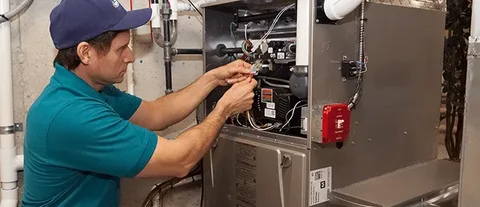Furnace Repair vs Replacement: How to Decide What’s Best for Your Home

When your furnace starts acting up in the middle of an Ontario winter, it’s natural to wonder, should you repair it or replace it altogether? For many homeowners, this decision can feel overwhelming. The good news is that the answer often comes down to a few key factors like your furnace’s age, repair frequency, and overall energy efficiency.
By understanding the difference between a short-term fix and a long-term solution, you can make a confident, cost-effective choice that keeps your home comfortable for years to come.
1. Consider the Age of Your Furnace
The average lifespan of a furnace in Ontario is about 15 to 20 years, depending on how well it’s maintained and the type of system you have. If your furnace is still under 10 years old and has been reliable so far, professional furnace repair is usually the best option.
However, if your system is approaching or past the 15-year mark, replacement might make more sense ,especially if efficiency has dropped or you’ve noticed rising utility bills. Even with regular tune-ups, older systems tend to lose performance over time, costing more to operate.
2. Look at How Often You Need Repairs
An occasional repair is normal, but if you’ve called a technician multiple times in the last two winters, your furnace may be signaling that it’s nearing the end of its lifespan. Frequent repairs can quickly add up, often costing more in the long run than replacing the unit outright.
A general rule of thumb: if the repair estimate is 50% or more of the cost of a new furnace installation, replacement is likely the smarter investment. New systems come with warranties and improved energy savings that offset the initial cost over time.
3. Pay Attention to Energy Efficiency
Older furnaces are typically less efficient, meaning they use more fuel or electricity to produce the same amount of heat. Modern high-efficiency models, often rated 95% AFUE (Annual Fuel Utilization Efficiency) or higher, can drastically reduce your monthly heating bills.
If your current furnace has an efficiency rating below 80%, you could be wasting a significant amount of energy each month. Upgrading to a new, high-efficiency system not only improves comfort but also contributes to a smaller environmental footprint.
4. Evaluate Heating Performance and Comfort
Inconsistent heating, cold spots, and longer run times are signs your furnace may no longer be keeping up. If your system struggles to maintain even temperatures, even after recent repairs, replacement could provide a lasting fix.
Modern furnaces offer variable-speed motors and advanced temperature control, providing quieter operation and more even heating throughout your home. For families tired of fluctuating comfort levels, this upgrade can be transformative.
5. Factor in Safety and Air Quality
Older furnaces, especially those running on natural gas, can develop cracks in the heat exchanger, a serious issue that can lead to carbon monoxide leaks. If your technician identifies this problem, replacement is the only safe option.
Beyond safety, newer systems often come equipped with enhanced filtration and humidity control features that help maintain better indoor air quality, an important consideration during Ontario’s dry, cold winters.
6. Think About Long-Term Value
While repairing may seem cheaper upfront, an aging system’s inefficiency and ongoing maintenance can make it more expensive in the long term. A new furnace not only reduces energy costs but also increases your home’s overall value and reliability.
If you’re unsure which route makes the most sense, consider scheduling a professional inspection. An experienced HVAC technician can provide a clear cost-benefit comparison based on your system’s current condition.
7. How to Make the Right Decision for Your Home
The best choice often depends on balancing current repair needs, energy costs, and future comfort goals. For example, if your furnace is still relatively young but needs a minor repair, fixing it makes sense. However, if it’s more than a decade old and struggling to heat your home efficiently, upgrading is likely the wiser investment.
To learn more about the signs that it’s time to consider replacement, read our guide on how to tell when to replace your furnace. It outlines clear warning signs that indicate when repairs are no longer worth it.
8. When to Consult a Professional
If you’re on the fence between repairing and replacing, it’s always worth getting an expert opinion. A certified HVAC technician can assess your furnace’s condition, energy performance, and repair history to help you make an informed decision.
At HVAC Near Me, we specialize in helping Ontario homeowners find the most cost-effective heating solution. Whether you’re repairing your current system or upgrading to a new one, we’ll guide you every step of the way to ensure your home stays warm and efficient all winter.
